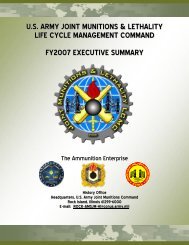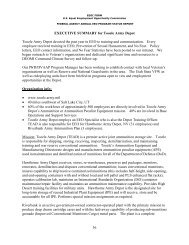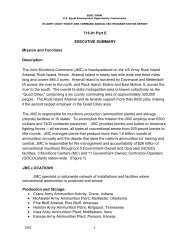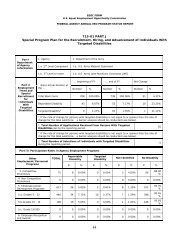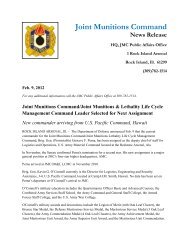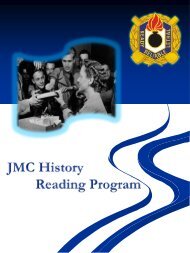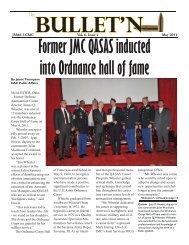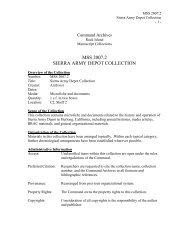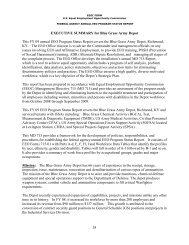History of the Ammunition Industrial Base - JMC - U.S. Army
History of the Ammunition Industrial Base - JMC - U.S. Army
History of the Ammunition Industrial Base - JMC - U.S. Army
Create successful ePaper yourself
Turn your PDF publications into a flip-book with our unique Google optimized e-Paper software.
could be sold on <strong>the</strong> open market. The reconversion <strong>of</strong> such facilities from a<br />
peacetime basis to a wartime basis would entail expenses which would be out<br />
<strong>of</strong> proportion to <strong>the</strong> income which <strong>the</strong> government could get for such facilities<br />
by lease or sale.” 61<br />
Ordnance Department analysis indicated that due to extremely limited commercial<br />
application for explosives, propellant, and load and assemble (LAP) <strong>of</strong> ammunition, <strong>the</strong>re was no<br />
strong motivation for commercial operators to build or own <strong>the</strong>ir own ammunition related plants.<br />
The lack <strong>of</strong> commercial demand for large-scale explosives production was well known. Of equal<br />
importance was <strong>the</strong> feast or famine nature <strong>of</strong> government ammunition requirements. The above<br />
quote noted that commercial facilities must maintain a minimum sustainment level <strong>of</strong> production<br />
or else ownership must convert to ano<strong>the</strong>r pr<strong>of</strong>it making enterprise. This later point had several<br />
aspects. First, while <strong>the</strong>re would be a continuing requirement for training ammunition, new<br />
development, and stock rotation, <strong>the</strong>se requirements were miniscule to those for war. Thus, <strong>the</strong><br />
plants had to have a huge surge capacity. The cost <strong>of</strong> maintaining that surge capacity would<br />
detract from pr<strong>of</strong>it margins, yet <strong>the</strong> underutilized capacity could not be converted to o<strong>the</strong>r<br />
commercial uses. In addition, commercial industry would have difficulty maintaining a skilled<br />
workforce to meet surge requirements, especially in <strong>the</strong> geographic areas where safety<br />
requirements dictated <strong>the</strong> location <strong>of</strong> explosive plants. This last point is a factor even at low<br />
level production. 62<br />
Besides <strong>the</strong> issues <strong>of</strong> pr<strong>of</strong>it motivation, <strong>the</strong> Chief <strong>of</strong> Ordnance cited <strong>the</strong> issue <strong>of</strong> military<br />
readiness. He made a direct connection between civilian enterprise in <strong>the</strong> opening months <strong>of</strong> <strong>the</strong><br />
Korean War, <strong>the</strong> role <strong>of</strong> <strong>the</strong> GOCO plants, and <strong>the</strong> shortage <strong>of</strong> ammunition. He noted that even<br />
GOCO plants took time to obtain full production, but <strong>the</strong>y were crucial in keeping ammunition<br />
flowing in <strong>the</strong> two years it took to ensure commercial industry reached full volume production. 63<br />
The Ordnance Department proposed it was in <strong>the</strong> best interest <strong>of</strong> <strong>the</strong> <strong>Army</strong> and Nation to<br />
maintain a primarily government-owned base for ammunition production, but to contract<br />
operations to private contractors. In addition to GOCO plants, <strong>the</strong> Ordnance Department<br />
maintained <strong>the</strong>ir pre-Korea procurement policy for metal parts and fuzes from commercial<br />
sources; but powder, explosive, and loading plants would remain in <strong>the</strong> organic government<br />
owned base. The OD clearly supported following DoD policy <strong>of</strong> private contracting for vehicles,<br />
weapons systems, and o<strong>the</strong>r commodities where commercial facilities can produce for both<br />
public and private consumption. However, <strong>the</strong> Department requested a waiver in order to keep<br />
ammunition production in GOCO facilities. They believed <strong>the</strong> shortages and problems <strong>of</strong> 1950-<br />
1952 would be a reminder <strong>of</strong> <strong>the</strong> need for a continuing “subsidy” <strong>of</strong> or investment in <strong>the</strong><br />
ammunition production base.<br />
Unfortunately, <strong>the</strong> Korean era ammunition shortages did not remain a priority as we<br />
entered <strong>the</strong> following peacetime period. By <strong>the</strong> time <strong>the</strong> Chief <strong>of</strong> Ordnance had made his<br />
recommendations, and implied that ammunition production required a steady level <strong>of</strong> funding;<br />
<strong>the</strong> <strong>Army</strong> had already entered <strong>the</strong> Pentomic Era. The New Look was based on deterrence and <strong>the</strong><br />
race for nation supremacy would focus on nuclear weapons. In <strong>the</strong> shift from conventional<br />
warfare to nuclear deterrence <strong>the</strong> Air Force would play a greater role in developing nuclear<br />
61 Ibid, 4, 7-8.<br />
62 Ibid, passim.<br />
63 OCO, Jan 1955, 7, 9.<br />
23



